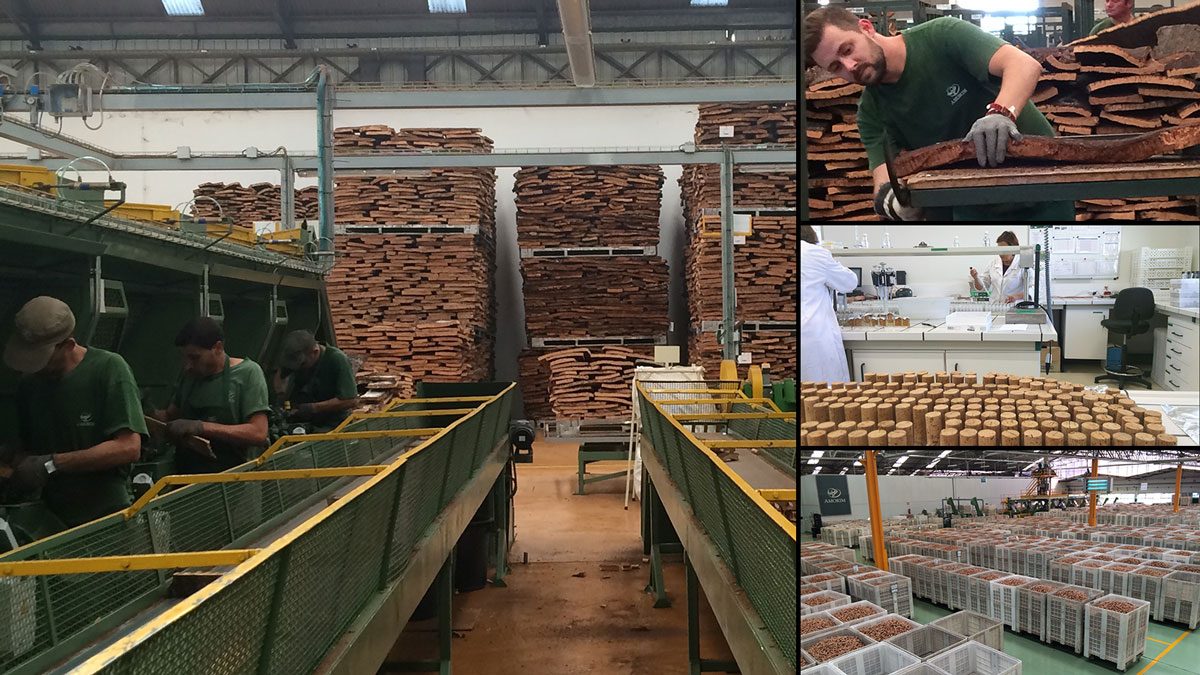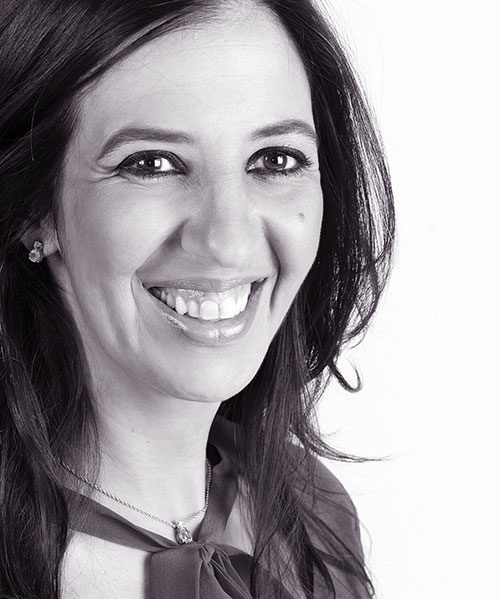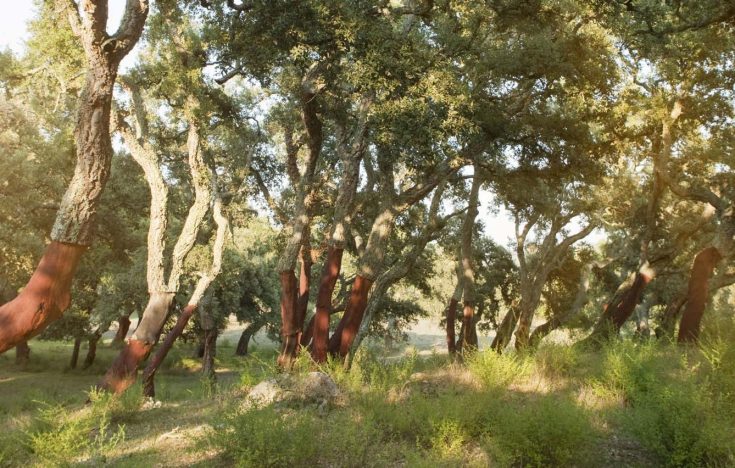
Amorim was established in
the heart of Portugal’s port wine region in 1870 and now has more than 22,000
clients in more than 100 countries. But remaining competitive in the industrial
age has been a challenge.
Cheap plastic stoppers and
aluminium screwcaps, introduced to the wine market in the 1990s, forced Amorim
to make a tough choice: move into these alternative products or stay in cork.
Amorim decided to stay in
cork, but maintaining a competitive edge meant innovating and investing heavily
in research and development to raise cork’s profile, and diversify into the
development of new products.
The group invests €7.5m a
year in R&D and innovation and even more in state-of-the-art technology and
new production processes.
This investment has paid
off, cementing Amorim’s position on the market, while improving customer
experience and becoming an environmental pioneer.
No more “corked” wine
Among these innovations is Amorim’s NDtech, which has allowed it to eliminate the risk of cork contaminated with releasable trichloroanisole (TCA), a naturally-forming chemical compound that can lead to wine tasting “corked”, a major problem for the wine industry.NDtech enables Amorim to detect any cork with more than 0.5 nanograms of TCA per litre, and to remove it from the production line. The group invested €10m over a five-year period in the development of the technology. Amorim has also developed a Helix twist-open cork to increase convenience for customers.
Recycling
Technological innovations have also enabled Amorim to integrate sustainability into all of its operations.Nothing is wasted in the cork production process and everything that cannot be used is recycled. Cork derived from the first two cork oak harvests, which cannot be used for cork stoppers, goes into the manufacture of other products such as insulation and flooring.
Biomass in the form of cork dust is used to meet 65% of Amorim’s energy needs, leading to important reductions in its carbon footprint. The group has also launched a major initiative to recycle cork stoppers in a number of countries. The recycled stoppers are ground up to create granules that become a raw material for other products.
Diversification
Another key element in Amorim’s transformation has been its diversification from cork stoppers into other cork products, not least in the construction industry. Cork’s lightness, insulation and fire retardant properties give it the edge in a range of applications.It is now used in spacecraft because of its role as a thermal insulator, with NASA and the European Space Agency using cork to protect the heat shields and plates lining their spaceships.
Cork is also employed in wind turbines, sports equipment and the construction of bridges and motorways, alongside longer established uses such as flooring.
Cork’s role in fighting climate change
Cork comes from the bark of the cork oak tree and the largest areas of cork oak forest are in western Mediterranean countries such as Portugal, Spain, Morocco and Algeria. Portugal boasts the largest area of cork oak forest in the world and accounts for 55% of the world’s annual cork production of 340,000 tonnes. A tonne of cork can provide an average of 66,700 cork stoppers.The cork oak trees are never cut down. Cork is harvested from the trunk without damaging the tree, which regenerates new bark. But this is a long process. A cork oak has an average lifespan of over 200 years, but it is 25 years before it can be harvested for the first time, with subsequent harvestings at nine-year intervals. And cork from the first two harvests is not suitable for the manufacture of stoppers. Only from the third harvesting, when the cork oak is 43 years old, is the cork of a high enough quality for the production of stoppers.
Cork oak forests protect against erosion and resulting desertification, provide a habitat for rare and endangered species, and can act as a barrier against fires because cork oaks are more fire resistant than other trees.
These forests also help fight climate change. Cork oak forests are estimated to retain up to 14 million tonnes of C02 a year. The manufacture of cork stoppers is also responsible for far fewer greenhouse gas emissions than other closures. C02 emissions from the manufacturing process are 10 times higher for plastic stoppers and 24 times greater for aluminium caps, according to a study by PwC.

Innovation drive presents financing challenges

Your decision to stay with cork, rather than moving into plastic and aluminium stoppers, must have involved a lot of investment in R&D and innovation over a long period. What has this cost?
It was a well thought-out decision but once we made that decision, the path was clear and so was the perception that significant R&D investments, in excess of €200m, were necessary over the course of several years. But the results of this strategy are clear, with key indicators registering significant improvements. Sales rose from €415m in 2009 to €605m in 2015, with EBITDA growing from €39m to €101m, resulting in an improvement in the EBITDA/sales margin from 9.3% to 16.7% over this period. And this margin reached 19.7% in the first half of 2016. Net profit climbed from €5m in 2009 to €55m in 2015, with return on invested capital rising from 3% to 14.3%, and we paid out total dividends of €117m between 2009 and 2015.What has your strategy been for financing this investment?
Over the past few years, Amorim has been aiming at lowering its overall remunerated debt and the strength of the company’s balance sheet clearly shows the results of that strategy. Our net debt went from €139m in 2009 to €80.1m at the end of the first half of 2016, mainly in loans but also some €10m in a bond issue. Net debt/EBITDA declined from 3.56 to 0.71 over the same period. And this was achieved while still growing organically and by acquisition, to the tune of an additional one billion bottle closures and thousands of new customers since 2010.But, of course, we were always aware that new interesting sources of financing were opening up for Portuguese companies with the sort of international exposure that we have, especially when coupled with a growth strategy that is producing positive results. And we took a serious look at these new opportunities.
Can you give some examples of your financing?
Last year we secured a loan from the European Investment Bank, which is a good example of the different financing strategy that, traditionally, Corticeira Amorim did not tap into in the past. The EIB loan of €35m was crucial in securing financing for a heavy R&D and innovation programme at a very interesting cost. We are very proud to have been able to explain to the EIB what we were doing and how we were doing it, and they decided to structure this 10-year deal with a grace period of four years. With this financing, Corticeira Amorim could substantially lengthen the maturity of its debt while, at the same, lowering considerably the average interest rate on our debt.Does the fact that you are involved in sustainability enable you to benefit from favourable financing terms or attract green financing?
A deal such as the one we have with the EIB reflects the lender’s commitment to supporting R&D as a crucial basis for long-term competitiveness which has to be based upon sustainable growth.When we look at international financial markets, we see a growing number of investors who consistently favour companies that are socially responsible, sustainable and profitable, as there is clear evidence that sustainable companies create shareholder value in the long run, because they are more prepared to face economic, social and environmental challenges – and this translates into lower risks for the investor and financier.
In fact, at Corticeira Amorim we believe that people will come to realise that they need to stop talking about concepts such as sustainable growth or sustainable development, and the sooner this happens the better. If it is not sustainable it really isn’t growth or development, is it? Increasingly, these issues must be seen from a holistic point of view. We believe lending institutions - such as BNP Paribas – that are at the forefront of this process play a major role in shaping this economic and societal evolution, recognising and supporting companies’ commitment towards sustainable development and social responsibility.
Does the fact that you are involved in a long process of innovation and an industry with long timescales also have financial implications?
Absolutely, it is inescapable for Amorim. In fact, in the cork sector everything happens over a long period. It takes, on average, 25 years before a cork oak can be harvested for the first time, and then it is harvested at nine-year intervals. Acquisition of the cork from the thousands of forest owners takes place over a three-month period, normally between May and July. We call it “the cork campaign”, because we must buy all the cork that we need for the next year. Our Raw Materials Business Unit then has to keep the cork for at least six months in a factory yard before any industrial process takes place. This obviously is quite demanding in terms of investment and financing needs.It is also important to highlight the international exposure of Corticeira Amorim and our global presence. We have 30 industrial units and 44 sales companies spread all over the world, so we need to carefully manage our raw material stocks within the industrial plants, as well as the stocks of finished goods within the sales network. The business has to be managed in a way that takes account of all these special and highly demanding financing needs.
Has your diversification into other products also raised any challenges in terms of financing?
When we look into R&D and innovation as much as we have, there is no forgetting that good projects mean good growth, but that also means good financing. Finding the right partners is a fundamental step in achieving success, and the financing of R&D is no exception. A long-term view and approach is crucial.Has it been easy to get support from banks for such long-term investments?
We have seen an important change in the international lending landscape. The 2008/2009 crisis, obviously, played a major role in this. But the adoption of more restrictive credit policies within a framework of increasingly demanding lending criteria benefits a solid company such as Corticeira Amorim.No company can reach its potential without robust relationships with the financial institutions. When the parties have dialogue and understand what is mutually expected, everything becomes easier. Of course, quality loans are a two-way street, but the significant growth we’ve enjoyed in the last years was also possible because we had the right funding partners. Growing companies mean a growing economy and that is more than just a win-win situation between lender and borrower. It means that both companies and financial institutions are doing what society expects us all to do. Being attuned to this is a crucial factor of success.
Amorim business model has required thinking outside the box

How has the bank helped Corticeira Amorim with its development and its innovations?
Corticeira Amorim is a very long-standing client and we have been supporting the group for more than 15 years. We try to support them in any way that they need us and we are working with them in several geographies, such as Portugal, France, Italy and the US.One of the things we are discussing with them right now is their inventory. Amorim’s business model is very atypical. The cork producers have to harvest the cork in a very short period between May and July. So Amorim has to acquire the raw materials and pay their producers during this period, but after that they have to keep the cork for a very long time – they keep it on their balance sheets and in their storehouses for 12 to 16 months. For Amorim it is an asset which is completely immobilised during this time.
One solution that we recently presented to them relates to inventory financing. At BNP Paribas we have a trading entity located in Dublin whose role is to acquire raw materials. So the raw materials go onto the balance sheet of this entity and we forward them to our clients, in this case Amorim, whenever they need them. This solution allows Amorim to reduce their inventory and only use the raw materials when they need them and when the cork is ready to be processed.
This does not interfere with Amorim’s logistics or commercial relationships with their suppliers. Amorim still keeps the raw materials in their warehouses but instead of having this inventory on their balance sheet, the bank acquires it and sells it to the group as and when they need it.
Another aspect of their business is that it involves very long timescales in terms of the investment in R&D and innovation, and the timescale of the cork industry itself. Has that been a particular challenge for the bank?
It is very challenging because R&D and innovation are in Amorim’s DNA, so we have to be innovative ourselves. For us it is a matter of presenting any business development that we think could help the group in their international development. It is very challenging but it is very nice problem to have.What sort of financing have you provided for them?
They have very high working capital requirements due to their atypical business model. We have provided them with short-term facilities to enable them to acquire the raw materials over a very short period of time. And of course we are helping the group with their forex hedging needs. They are one of the most international Portuguese groups and operate in a huge number of countries, so they are exposed to several currencies and we work with them to hedge this currency risk.Do you provide any other services to them beyond purely financial products?
They are still looking for international growth opportunities and we are helping them on the advisory side. Within the BNP Paribas network, we are trying to identify any potential growth opportunities for Amorim. Amorim has a very good knowledge of their market and their competitors, but we have had some interesting conversations with them on possible growth opportunities.Do you need a very strong understanding of the mechanics of a client’s business to be able to provide the sort of support they need?
Yes, it is critical because if you do not understand their business model, you will not be able to propose solutions that can help them.:Beyond the example of Amorim, is there is a BNP Paribas-specific approach to the financing of innovation in businesses in general?
Being in charge of the global relationship with a client at an international bank, we are very lucky to have dedicated business lines and experts in all kinds of financing that we might propose to our clients. I would say that the main goal of a global relationship manager is to identify business opportunities and, as soon as we identify them, to discuss them with our colleagues, whether they are located in Portugal, London or Madrid. We are business opportunity detectors.Are you different to other banks in your approach to businesses involved in innovation?
If you compare BNP Paribas to our main global international banking peers, I would say that we are both local and global. We have a very strong local presence, so we are close to our clients, not only in Portugal but in several European countries thanks to our network. But we also have global experts who help our clients with any financial opportunities or needs that they may have. We have this combination, which I believe in Portugal is quite rare, of being a strong international bank with a local presence. My job as a global relationship manager is to be local and close to my clients, but with all the expertise in banking activities and business line that our more international clients may need. We have this combination that other international banks with only a representative office here in Portugal may lack.Has your experience with Amorim helped BNP Paribas itself to innovate in any way, for example in developing new products and services?
The inventory financing plan that we are discussing is quite new. Amorim are very open-minded and open to exploring new financing solutions. And of course at the global bank we have similar expertise in other geographies, and we are already working with other clients on these sorts of financial solutions.Has your experience with Amorim helped BNP Paribas find them new opportunities elsewhere?
We are working with Amorim in several geographies – more geographies than any other international bank – and we have already provided some financing for them in the US. We are working with them in the Napa Valley through our Bank of the West subsidiary.Has your experience with Amorim and the new types of financing you have developed for them led to opportunities with other clients?
Yes, we are working with other clients in North Africa who are suppliers of Amorim. Thanks to our relationship with Amorim we have been able to introduce those suppliers to our local branches in Morocco and Algeria. And our relationship with the group has allowed us to identify business opportunities with some other firms that are working for or with Amorim in other geographies.
